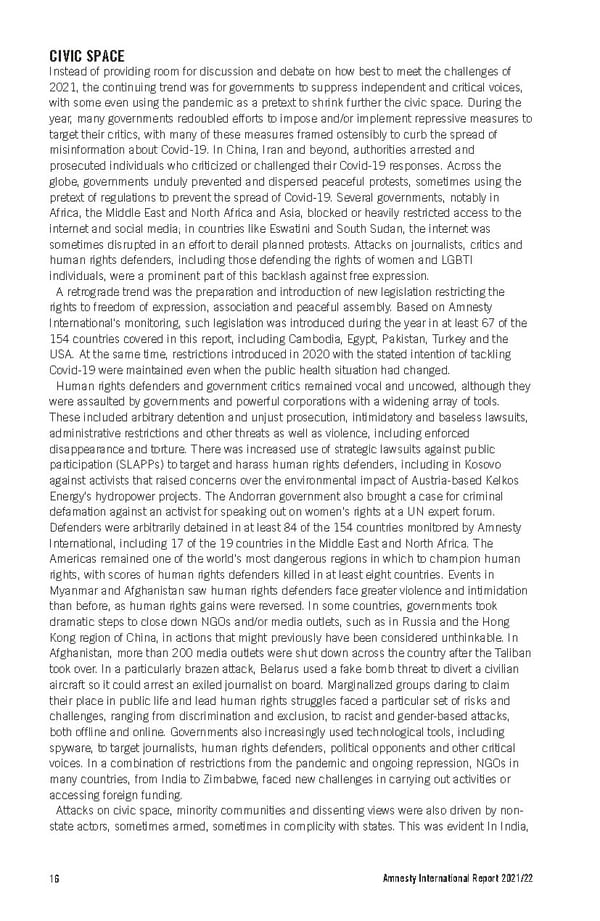CIVIC SPACE Instead of providing room for discussion and debate on how best to meet the challenges of 2021, the continuing trend was for governments to suppress independent and critical voices, with some even using the pandemic as a pretext to shrink further the civic space. During the year, many governments redoubled efforts to impose and/or implement repressive measures to target their critics, with many of these measures framed ostensibly to curb the spread of misinformation about Covid-19. In China, Iran and beyond, authorities arrested and prosecuted individuals who criticized or challenged their Covid-19 responses. Across the globe, governments unduly prevented and dispersed peaceful protests, sometimes using the pretext of regulations to prevent the spread of Covid-19. Several governments, notably in Africa, the Middle East and North Africa and Asia, blocked or heavily restricted access to the internet and social media; in countries like Eswatini and South Sudan, the internet was sometimes disrupted in an effort to derail planned protests. Attacks on journalists, critics and human rights defenders, including those defending the rights of women and LGBTI individuals, were a prominent part of this backlash against free expression. A retrograde trend was the preparation and introduction of new legislation restricting the rights to freedom of expression, association and peaceful assembly. Based on Amnesty International’s monitoring, such legislation was introduced during the year in at least 67 of the 154 countries covered in this report, including Cambodia, Egypt, Pakistan, Turkey and the USA. At the same time, restrictions introduced in 2020 with the stated intention of tackling Covid-19 were maintained even when the public health situation had changed. Human rights defenders and government critics remained vocal and uncowed, although they were assaulted by governments and powerful corporations with a widening array of tools. These included arbitrary detention and unjust prosecution, intimidatory and baseless lawsuits, administrative restrictions and other threats as well as violence, including enforced disappearance and torture. There was increased use of strategic lawsuits against public participation (SLAPPs) to target and harass human rights defenders, including in Kosovo against activists that raised concerns over the environmental impact of Austria-based Kelkos Energy’s hydropower projects. The Andorran government also brought a case for criminal defamation against an activist for speaking out on women’s rights at a UN expert forum. Defenders were arbitrarily detained in at least 84 of the 154 countries monitored by Amnesty International, including 17 of the 19 countries in the Middle East and North Africa. The Americas remained one of the world’s most dangerous regions in which to champion human rights, with scores of human rights defenders killed in at least eight countries. Events in Myanmar and Afghanistan saw human rights defenders face greater violence and intimidation than before, as human rights gains were reversed. In some countries, governments took dramatic steps to close down NGOs and/or media outlets, such as in Russia and the Hong Kong region of China, in actions that might previously have been considered unthinkable. In Afghanistan, more than 200 media outlets were shut down across the country after the Taliban took over. In a particularly brazen attack, Belarus used a fake bomb threat to divert a civilian aircraft so it could arrest an exiled journalist on board. Marginalized groups daring to claim their place in public life and lead human rights struggles faced a particular set of risks and challenges, ranging from discrimination and exclusion, to racist and gender-based attacks, both offline and online. Governments also increasingly used technological tools, including spyware, to target journalists, human rights defenders, political opponents and other critical voices. In a combination of restrictions from the pandemic and ongoing repression, NGOs in many countries, from India to Zimbabwe, faced new challenges in carrying out activities or accessing foreign funding. Attacks on civic space, minority communities and dissenting views were also driven by non- state actors, sometimes armed, sometimes in complicity with states. This was evident In India, Amnesty International Report 2021/22 16
 Amnesty International Report 2021/22 Page 15 Page 17
Amnesty International Report 2021/22 Page 15 Page 17